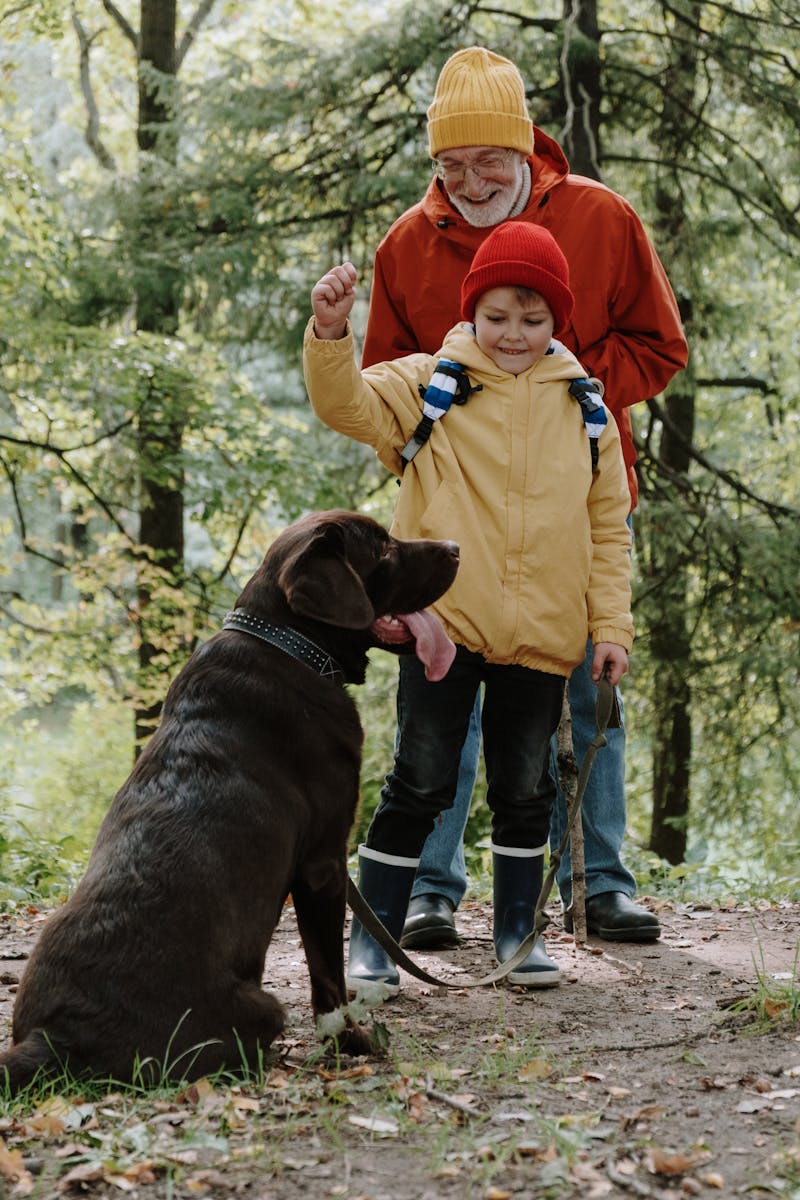Behavior Changes After Adoption: Understanding Your Relationship with Your Pet
Understanding Behavior Changes in Pets After Adoption: A Comprehensive Guide
Adopting a pet is a heartwarming journey filled with excitement, love, and sometimes unexpected challenges. Each year, millions of animals find new homes, transitioning from shelters to loving families. However, this shift is not merely a change of scenery for a pet; it often leads to various behavior changes that can be surprising and challenging for new pet parents. Understanding these behavior changes is crucial for fostering a strong, healthy bond with your new furry friend and ensuring a smooth transition into their forever home.
In this blog post, we’ll dive deep into why pets display behavioral shifts post-adoption, the common changes you might witness, and what you can do to help your pet adjust comfortably.
The Importance of Understanding Behavior Changes
When you bring a pet home, you’re not just gaining a companion; you’re introducing them into a new environment, filled with new sounds, smells, and people. This transition can create an array of emotions for pets, from joy to anxiety. As a responsible pet owner, recognizing and understanding these behavior changes is vital for several reasons:
- Building Trust: Understanding your pet’s behavior helps build a foundation of trust. Animals sense their owners’ awareness of their emotional states, leading to a more empathetic relationship.
- Promoting Well-Being: Being aware of and addressing behavioral changes can enhance your pet’s mental and physical well-being, reducing stress and promoting happiness.
- Preventing Issue Escalation: By recognizing and addressing behavioral issues early on, you can prevent them from escalating into more significant problems, such as aggression, fearfulness, or destructive habits.
Common Behavior Changes in Adopted Pets
1. Anxiety and Fear
It’s common for newly adopted pets to feel uncertain and fearful in their new environment. Sudden changes can lead to anxiety, prompting behaviors such as:
- Hiding or retreating to a safe space
- Excessive barking or meowing
- Pacing or restlessness
In extreme cases, this anxiety might lead to destructive behaviors like chewing on furniture or scratching at doors. As a pet owner, patience is key. Establish a routine that includes a safe space where your pet can retreat when feeling overwhelmed.
2. Changes in Social Interactions
Pets may also react differently to social interactions, whether with their new families, other pets, or strangers. Some common shifts include:
- Avoiding contact with new humans or animals
- Displaying more clinginess to their new owners
- Being overly cautious or aggressive during playtime
To help navigate social changes, consider introducing your pet to new people and situations slowly and in controlled environments. This gradual exposure will help your pet build confidence.
3. Changes in Eating Habits
Adopting a pet can also result in noticeable shifts in eating behaviors. Adopted pets may experience:
- A loss of appetite due to stress
- Overeating as a comfort mechanism
- Sniffing at food but not eating
Encourage healthy eating habits by maintaining a consistent feeding schedule and providing a calm environment during meals. Additionally, consult your veterinarian if changes in appetite persist, as they may indicate underlying health issues.
Tips for Managing Behavior Changes Post-Adoption
1. Establish a Routine
Pets thrive on routine. Establish a consistent schedule for feeding, potty breaks, playtime, and quiet time. This predictability will help your pet feel secure in their new home.
2. Create a Safe Space
Designate a quiet area as your pet’s safe space, equipped with their bed, toys, and a few comfort items. This will provide them a refuge to retreat when feeling overwhelmed.
3. Use Positive Reinforcement
Encourage good behavior using positive reinforcement techniques like treats, praise, and affection. This will help reinforce desirable behaviors and build trust between you and your pet.
4. Be Patient and Allow Time
Every pet is different, and adjusting to a new home can take time. Be patient and empathetic, allowing your pet to acclimate at their own pace. Recognize that some behavior changes may take several weeks or even months to resolve.
5. Seek Professional Help If Needed
If you notice persistent negative behaviors, consider seeking guidance from a professional pet trainer or behaviorist. They can provide tailored advice and strategies to help manage specific issues.
Conclusion: Embracing the Journey of Change
Understanding behavior changes in pets after adoption is a fundamental aspect of nurturing your new companion. By recognizing the emotional and psychological shifts that come with such a life change, you’re equipping yourself with the tools necessary to provide them the care, love, and support they need to thrive.
Remember, patience, empathy, and knowledge go a long way in creating a happy home for your furry friend. As you embrace this journey, you’ll find that the bond you develop with your pet is profoundly rewarding and filled with love.
Common Behavioral Issues After Adoption: Understanding Anxiety, Fearfulness, and Aggression
When adopting a pet, it’s essential to be prepared for the range of emotional and behavioral challenges they may face during their transition. As discussed earlier, anxiety and fear are common responses to a new environment, but they can manifest in various behavioral issues that can be surprising to new pet parents. Understanding these issues can enhance your ability to support your pet while forging a meaningful bond.
In this section, we’ll explore common behavioral issues your pet may exhibit after adoption, focusing on anxiety, fearfulness, and aggression, and provide actionable strategies to help manage these challenges.
1. Anxiety in Adopted Pets
Anxiety is one of the most prevalent behavioral issues observed in adopted pets. The new sights and sounds of their environment can overwhelm them, often leading to distress. Some indicators of anxiety include:
- Excessive Barking or Meowing: Pets may vocalize more than usual due to anxiety, expressing their discomfort or seeking attention.
- Destructive Behavior: Items around the home may become targets of chewing or scratching as a pet attempts to cope with their anxiety.
- Pacing or Restlessness: A frequently anxious pet may have difficulty settling down, exhibiting signs of unease and stress.
To help mitigate anxiety, consider the following strategies:
- Create a Calm Environment: Ensure your home’s atmosphere remains serene. Soft music or white noise can drown out sudden loud noises that may trigger anxiety.
- Introduce Gradually: When introducing new experiences or household members, do so gradually to prevent overwhelming your pet. Give them time to adjust to each new situation.
- Utilize Anxiety-Relief Aids: Products such as anxiety wraps, calming pheromones, or even natural supplements can provide additional support in managing a pet’s anxiety.
2. Fearfulness and Phobias
Fearfulness is another significant issue commonly seen in adopted pets, particularly for those who may have had traumatic backgrounds. Signs of fearfulness can include:
- Hiding or Retreating: A fearful pet may seek refuge in secluded areas of the home, avoiding interaction with family members.
- Shaking or Cowering: Physical signs of fear like trembling, cowering, or tucking their tail can indicate anxiety or distress.
- Aggressive Responses: In some cases, fear can trigger aggressive behavior as a defense mechanism, especially if a pet feels threatened.
To support a fearful pet, consider the following:
- Socialization: Gently expose your pet to new experiences and environments in controlled settings. This can help them acclimate to various situations and build confidence.
- Use of Treats: Create positive associations with previously feared objects or situations by pairing them with treats or favorite toys, encouraging exploration and reducing fear.
- Avoid Punishment: Never punish a pet for exhibiting fearful behaviors. Instead, focus on providing comfort and encouragement.
3. Aggression: Understanding Triggers and Responses
While aggression can be a serious issue, it is essential to understand that many aggressive behaviors stem from fear or insecurity rather than a lack of temperament. Identifying triggers is crucial for effective management. Some signs of aggression might include:
- Snarling, Growling, or Biting: These behaviors are often indicators of fear, pain, or the need to establish territory.
- Stiff Body Language: An aggressive pet may exhibit rigid body posture or raised hackles, indicating heightened defenses.
To address aggression, employ these strategies:
- Identify Triggers: Observe your pet closely to determine what situations trigger their aggression. This will help you manage their exposure to such triggers effectively.
- Behavior Modification Techniques: Consult with a professional trainer or behaviorist to develop a customized behavior modification plan, using positive reinforcement to encourage appropriate behavior.
- Prioritize Training: Basic training commands can help provide structure and reassurance for your pet, fostering better communication and understanding between you and your furry friend.
4. Seeking Help for Behavioral Issues
If you find that your pet’s behavioral issues are persistent or causing distress for either of you, do not hesitate to seek professional help. Pet trainers, behaviorists, or veterinarians can offer tailored advice, support, and potentially recommend additional interventions such as therapy or behavior management techniques.
Conclusion: Understanding and Supporting Your Pet’s Needs
Every pet is unique and will adapt to their new environment at their own pace. Recognizing common behavioral issues such as anxiety, fearfulness, and aggression allows you to take the necessary steps to help your pet adjust comfortably to their new home. Understand that patience and empathy are key components in overcoming these challenges and fostering a trusting bond with your adopted friend.

Adjustment Period: Understanding Your Pet’s Transition After Adoption
When you welcome a new pet into your home, you’re embarking on a journey of mutual understanding and companionship. However, the excitement of the adoption process is often accompanied by an adjustment period, during which your new furry friend acclimates to their new environment. This transition can be accompanied by a variety of emotional and behavioral changes as your pet processes its new reality. Understanding the typical adjustment period for pets and learning about the factors that can influence it are crucial for nurturing a positive and supportive environment.
Understanding the Adjustment Period
How Long Does the Adjustment Period Last?
The adjustment period can vary significantly from one pet to another, often lasting anywhere from a few days to several months. On average, most pets take about two to three weeks to adjust to new surroundings and routines, while some may take longer, particularly if they come from challenging or traumatic backgrounds. It’s essential to note that this timeline isn’t set in stone; every pet is unique, and their past experiences will greatly influence this adjustment phase.
Key Factors Influencing Adjustment Time
Several factors can affect how quickly a pet adjusts after adoption. Here are some important elements to consider:
- Background History: Pets adopted from shelters or rescue organizations often come with diverse experiences. Pets that have faced neglect or abuse may take longer to build trust and feel secure than those who were previously in loving homes.
- Age: Younger pets may adapt to new environments more quickly than older ones who may have established routines or social norms. Conversely, older pets might require more time to feel comfortable due to established feelings of stability or routines in their previous homes.
- Temperament: Each animal has its personality traits that can influence their adjustment. Some pets are naturally more confident and curious, while others may be anxious or timid, impacting their readiness to explore their new environment.
- Socialization History: Pets that have had extensive socialization with people and other animals before adoption may adapt more quickly. In contrast, those with limited socialization may need extra encouragement to engage with their new family and environment.
- Home Environment: The atmosphere of your home will also play a significant role. A calm, quiet home with predictable routines can facilitate a smoother transition. Conversely, a chaotic environment with lots of loud noises and sudden movements might overwhelm a nervous pet.
Strategies to Ease the Adjustment Period
1. Create a Welcoming Environment
Set up a specific area for your new pet that’s quiet and free from distractions. Utilize comforts such as beds, toys, and familiar items to help them feel at home. Maintaining a consistent setup will help stabilize their emotional state.
2. Gradual Introductions to Family Members and Space
If you have other pets or family members, introduce them gradually. Allow your new pet to explore individual areas of your home slowly, rather than overwhelming them with the entire space at once.
3. Establish a Consistent Routine
As mentioned earlier, routine is key. Create a structured schedule regarding feeding times, potty breaks, play sessions, and quiet moments. Predictability can help significantly reduce anxiety for both you and your pet.
4. Positive Reinforcement
Utilize positive reinforcement techniques throughout the adjustment period. Reward your pet with treats, praise, or affection for engaging with you or exploring their environment. This will help reinforce good behavior and build confidence.
5. Be Patient
It’s essential to allow your pet to adjust at their own pace. Some may require more time to feel secure and relaxed, while others may quickly adapt to their new life. During this phase, patience is crucial, so be prepared to face initial hurdles with empathy and understanding.
6. Monitor Behavior Changes
Keep an eye on your pet’s behavior during the adjustment period. If you notice any signs of excessive stress, anxiety, or behavioral issues, it may be beneficial to consult a veterinarian or a pet behaviorist for tailored strategies.
Conclusion: Embracing Change Together
The adjustment period for your newly adopted pet is a vital phase in nurturing a strong bond and ensuring their emotional well-being. Understanding that this transition may take time and is influenced by various factors will better equip you to provide the comforts they need. Always remember to have patience and empathy, allowing your pet the space to find their footing in their new home.
By fostering an environment where your pet can thrive, you will lay the foundation for a loving and lasting relationship.

Past Experiences: How a Pet’s Previous Environment Influences Behavior
When welcoming a pet into your home, it’s important to understand that every animal comes with a unique background that affects their behavior. A pet’s past experiences—including trauma, neglect, or even positive interactions—play a critical role in how they may react to you and their new surroundings. This post will explore the impact of previous experiences on a pet’s behavior after adoption, and how recognizing these influences can help foster a smoother transition.
The Impact of Trauma and Neglect
1. The Signs of a Traumatized Pet
Pets who have experienced trauma may exhibit various behavioral signs after adoption, making it essential for new owners to recognize these indicators:
- Fear and Avoidance: Many traumatized pets may react with fear to specific stimuli, including loud noises, sudden movements, or unfamiliar scents. Signs can include cowering, hiding, or running away.
- Aggression: Some pets may respond to fear with aggression, which can manifest as growling, snapping, or biting. This can be their way of self-protection, rooted in a need to feel safe.
- Hypervigilance: Pets with a history of neglect or abuse often remain on high alert, constantly scanning their environment for potential threats. This may lead to restlessness, pacing, or unusual guarding behaviors.
By understanding these signs of trauma, pet owners can create a nurturing environment that promotes healing and builds trust.
2. Behavioral Changes Linked to Past Experiences
The following behavioral changes in adopted pets often correlate with their previous environments and experiences:
- Separation Anxiety: Pets that have experienced abandonment may struggle with separation anxiety when their new owners leave. Symptoms can include distress barking, whining, or destructive behaviors when left alone.
- Over-attachment: Conversely, some pets might exhibit excessive clinginess, leading them to follow their owners everywhere, seeking constant reassurance and validation.
- Fearful Responses: Even commonplace situations—such as a doorbell ringing or a vacuum running—can trigger fearful responses in pets that were excessively punished or neglected in the past.
Understanding these behavioral responses can empower new pet parents to approach their pets with sensitivity and care, gradually helping to rewire their emotional responses.
Common Traits of Neglected Animals
Pets from neglectful backgrounds may display specific behaviors as a result of their past. These can include:
- Food Scarcity Mentality: Some pets might hoard food, consume it too quickly, or appear overly anxious during mealtime, stemming from a past where food was scarce.
- Social Withdrawal: Pets who have not been adequately socialized may show apprehension toward humans and other animals. They may find it difficult to engage, preferring solitude over interaction.
- Uncontrolled Excitement: On the flip side, some neglected animals may respond to comfort and love with overwhelming excitement or exuberance, which can lead to jumping, barking, or other forms of hyperactivity.
Recognizing these traits allows new owners to set realistic expectations regarding their pet’s behavior and helps inform the proper approach in overcoming these challenges.
Strategies for Supporting Pets with Troubling Histories
1. Approach with Understanding
When adopting a pet with a troubled past, it’s vital to approach them with understanding and empathy. Take time to observe your new companion’s behavior before making any assumptions. This understanding can help foster a supportive atmosphere where your pet feels safe.
2. Gradual Reintegration into Home Life
Introduce changes to your pet’s environment in a gradual manner. Here are some strategies:
- Controlled Introductions: Allow your pet to meet new people and other pets in a controlled manner. Use positive reinforcement to reward calm and relaxed behavior during these interactions.
- Create Routine: Establish a consistent daily routine that includes feeding, playtime, and quiet time. This predictability can help your pet feel more secure over time.
3. Utilize Comfort Items
Utilize comfort items that your pet can associate with security, such as a specific blanket, a toy, or even worn articles of clothing that carry your scent. These items can provide emotional stability and help reduce anxiety.
4. Encourage Positive Connections
Use positive reinforcement to encourage desirable behaviors by offering treats, praise, or affection. This not only strengthens your bond but also helps reassure your pet that they are safe and loved.
5. Seek Professional Guidance
If your newly adopted pet displays persistent or severe behavioral issues, consider seeking help from a trained animal behaviorist or professional trainer. They can help assess the situation and provide tailored strategies to manage specific problems.
Conclusion: Embracing the Challenges of Past Experiences
It’s crucial to remember that a pet’s previous experiences deeply influence their behavior upon adoption. As a new pet parent, having knowledge and understanding about the impact of trauma and neglect can significantly aid in your pet’s adjustment process.
By approaching your pet with empathy, patience, and the right strategies, you can create a nurturing environment that encourages healing and fosters genuine companionship.

Creating a Safe Space for Your Adopted Pet
When welcoming a new pet into your home, especially one that has transitioned from a shelter or previous environment, establishing a safe and comfortable space is paramount. A designated safe space can significantly ease the transition for your furry friend, promoting a sense of security and well-being. Below are actionable tips on how to create a safe sanctuary for your adopted pet, ensuring that their adjustment is as smooth as possible.
1. Choosing the Right Location
The first step in creating a safe space is selecting an optimal location within your home. Here are some key considerations:
- Quiet Spot: Find a multifunctional area away from the hustle and bustle of daily activities, such as a seldom-used guest room or a cozy corner in your living area.
- Avoid High Traffic Zones: Ensure it’s not adjacent to loud appliances or near frequently visited areas to help minimize stress.
- Accessible Yet Secure: Your pet should feel secure yet able to observe the household if they wish. A location with a view of the main room can help them feel included while still having a retreat.
2. Essential Items for Comfort
Once you have a designated area, it’s time to equip it with essential items that will help your pet feel more at home:
- Bed or Blanket: Provide a soft, comfortable bed or a familiar blanket that has either your scent or theirs. This tactile comfort can help them feel more secure.
- Toys: Include a few toys that your pet enjoys. Chew toys or comfort items can keep them occupied and alleviate anxiety.
- Food and Water Bowls: Have non-spill bowls designated solely for their safe space. Keep fresh water available at all times to ensure they stay hydrated.
3. Introduce Familiar Scents
Reassuring scents can soothe your pet and remind them of their previous home, even if it was less than ideal. Here are some ways to do this:
- Use Items from the Shelter: If possible, bring home an item that smells like their previous living environment, like a blanket or a toy from the animal shelter.
- Your Scent: Spend some time near their safe space, allowing your pet to become familiar with your scent. You can also wear clothing that carries your fragrance.
4. Gradual Introduction to New Experiences
While it’s essential to make your pet’s safe space comfortable, it’s equally important to manage their exposure to new experiences gradually:
- Slowly Introduce Family Members: Allow your pet to meet individual family members one at a time. This controlled introduction is less overwhelming and helps build trust.
- Minimize Loud Noises: At the beginning, keep noise levels low. Avoid loud music, sudden movements, or yelling, creating a calm atmosphere.
- Limit Guests: Don’t overwhelm your pet with visitors until they’re comfortable in their new environment. Give them time to adjust before introducing new people.
5. Use of Pheromones
Consider using synthetic pheromone products designed for pets, which can help reduce anxiety and create a calming atmosphere. These products come in various forms, including:
- Plug-in Diffusers: These release pheromones gradually and can be placed in your pet’s safe space.
- Sprays: You can apply calming sprays onto their bedding or safe area to promote relaxation.
Conclusion: Creating an Oasis for Your Furry Friend
Providing a safe space for your adopted pet is not just about physical items; it’s about creating a nurturing environment that fosters trust and comfort. By considering location, familiar scents, and gradual introductions to new experiences, you can help your pet feel at ease in their new home.
Your furry friend has been through a lot of changes, and creating a sanctuary can significantly enhance their sense of safety and belonging. Remember, patience and empathy in this transition will go a long way in strengthening your bond.

Signs of Stress in Pets: Identifying Indicators that Your Furry Friend May Be Feeling Overwhelmed in Their New Home
As you’ve learned in the previous sections, adopting a pet can be a transformative experience for both you and your new furry companion. However, the transition can be quite overwhelming for your pet. As they navigate their new surroundings, they may exhibit signs of stress that require your attention. Being aware of these indicators is crucial to ensuring your pet’s comfort and well-being. In this section, we’ll explore the key signs that may indicate your pet is feeling stressed in their new home.
Understanding Stress Signs in Pets
Pets communicate primarily through body language and behavior changes. Understanding their signals can help you recognize when they are feeling anxious or stressed. Here are some common signs to watch for:
1. Changes in Body Language
The way your pet carries themselves can reveal a lot about their emotional state. Some subtle and not-so-subtle body language changes include:
- Cowering or Tucking Tail: If your pet is worried or scared, they might lower their body and tuck their tail between their legs as a way to shield themselves.
- Ears Back or Alert: A significant change in ear position can indicate stress. When a pet’s ears are pinned back against their head, they may be anxious.
- Dilated Pupils: If your cat or dog has dilated pupils, this might be a sign that they are feeling threatened or stressed.
2. Excessive Grooming or Scratching
You may notice that your pet is grooming themselves more than usual or excessively scratching. For cats, this may mean grooming to the point of creating bald patches, while for dogs, you might see them scratching their skin or licking specific areas. This compulsive behavior can often signal anxiety or discomfort in their new environment.
3. Changes in Vocalization
Take note of any changes in your pet’s vocal habits. You may find that:
- Increased Barking or Meowing: Your pet may become more vocal when stressed, expressing discomfort or anxiety through excessive barking (dogs) or vocalizing (cats).
- Whining or Whimpering: This behavior is often a clear sign of distress. If you notice this, consider how your pet’s environment may be contributing to their discomfort.
4. Altered Sleeping Patterns
Just like humans, pets can struggle with sleep when they are feeling stressed. Changes may include:
- Restlessness: Rather than sleeping soundly, your pet may seem uneasy, constantly changing positions or pacing at night.
- Hiding Away: Some pets may choose to isolate themselves in a quiet, less-traveled area when they feel overwhelmed, indicating that they are seeking comfort and safety.
5. Loss of Interest in Favorite Activities
Every pet has their favorite activities, whether it’s playing with toys, going for walks, or interacting with you. When stress takes over, you may notice that:
- Hesitance to Play: Your pet might suddenly show little interest in toys or games that used to excite them, which can be concerning.
- Reluctance to Explore: If your pet is typically curious but now seems hesitant to explore their new home, it may indicate that they are feeling insecure and overwhelmed.
Tips for Supporting Stress Management
Recognizing the signs of stress is just the first step; you also need actionable strategies to help your pet feel more at ease. Consider the following tips:
1. Create a Routine
Routine is incredibly valuable for pets dealing with stress. Maintaining a consistent schedule for everyday activities – feeding, walking, and playtime – helps make the environment predictable and secure.
2. Provide Safe Spaces
Designate quiet areas within your home where your pet can retreat when they feel stressed. Equip this space with their favorite bedding, toys, and comforting scents, allowing them to choose when to engage or withdraw.
3. Engage in Gentle Play
Encouraging gentle playtime can help your pet regain their confidence. Use toys, interactive games, or find calming activities that won’t overwhelm them as they adjust to their new environment.
4. Use Soothing Aids
Consider using calming products, like pheromone diffusers, anxiety wraps, or calming treats that can help reduce stress levels. Always consult your veterinarian before introducing new products to ensure they are safe for your pet.
5. Seek Professional Guidance
If you are noticing prolonged or severe stress symptoms in your pet, it may be beneficial to talk to your veterinarian or a professional animal behaviorist. They can help create an individualized plan to address specific stressors and offer additional support.
Conclusion: Nurturing Your Pet’s Emotional Health
Identifying the signs of stress in your pet is essential for fostering a nurturing environment during their adjustment period. By paying close attention to their body language, vocalizations, and behavior changes, you’re taking significant steps to ensure they feel safe and loved in their new home. Remember, your patience and understanding will guide them toward feeling secure, leading to a stronger bond between you.

The Power of Positive Reinforcement in Helping Pets Adapt
When welcoming a new pet into your home, adjusting to their new environment can be daunting for both you and your furry friend. One of the most effective strategies for facilitating this transition is the use of positive reinforcement. This method not only encourages good behavior but also helps your pet develop trust in you as their caretaker. Below, we explore why positive reinforcement is crucial in helping pets adjust successfully to their new surroundings.
Understanding Positive Reinforcement
Positive reinforcement is a training technique based on rewards to encourage desired behaviors. When a pet performs a behavior and is rewarded with treats, praise, or affection, they are more likely to repeat that behavior in the future. This conditioning can be particularly helpful for adopted pets that may come with anxiety or uncertainty stemming from their past experiences.
Key Benefits of Positive Reinforcement:
- Reduces Fear and Anxiety: By rewarding your pet for good behavior, you create a positive association with new experiences, reducing anxiety and building their confidence.
- Strengthens the Bond: Consistent reinforcement fosters trust and deepens the emotional connection between you and your pet.
- Encourages Learning: Positive reinforcement can speed up the learning process for commands and cues, making it easier for your pet to adapt to household rules.
Implementing Positive Reinforcement Techniques
Here are some actionable tips to effectively use positive reinforcement with your new pet:
1. Identify Rewarding Behaviors
Observe your pet closely. Identify specific behaviors you want to encourage, such as:
- Using the litter box or going outside for bathroom needs.
- Sitting quietly when asked.
- Approaching you calmly instead of hiding.
Focus on small, manageable tasks that will help build your pet’s confidence.
2. Use High-Value Treats or Rewards
Select treats that your pet finds exciting and enjoyable. You may have to experiment with different options such as:
- Small pieces of cooked chicken or turkey for dogs.
- Soft, chewy treats for cats.
- Their favorite toy as a reward for playing calmly.
3. Timing is Everything
Immediate reinforcement is key to effective training. As soon as your pet exhibits the desired behavior, reward them promptly with a treat or praise. This swift response helps them associate their action with the positive outcome.
4. Praise and Affection
Don’t underestimate the power of verbal praise and physical affection. A warm, enthusiastic “good job!” combined with a gentle pet can be just as rewarding as a treat, especially for pets that thrive on your attention.
Real-World Examples of Success
Many pet parents have successfully employed positive reinforcement in their training. Here are two typical scenarios:
- Case of Rufus the Rescue Dog
After being adopted, Rufus was initially anxious and would bark excessively whenever someone knocked on the door. His owner used positive reinforcement by rewarding him with treats and praise whenever he remained quiet during arrivals. Over time, Rufus learned to associate door knocks with a calm response, significantly reducing his anxiety. - Mittens the Shy Cat
Mittens had a difficult past and tended to hide under the couch. Her new owner would leave treats in her safe space and gradually encourage her to come out. Each time Mittens ventured out to eat, she was greeted with loving words and more treats. The consistent positive reinforcement helped Mittens gain confidence and eventually enjoy interactive playtime.
Tips for Successful Positive Reinforcement
- Be Consistent: Consistency is essential; ensure everyone in the household is on the same page regarding training practices.
- Set Realistic Goals: Understand that behavioral changes take time, especially when dealing with anxious pets. Patience is key.
- Monitor Progress: Keep track of your pet’s response to training. Adjust your reinforcements as needed, ensuring that they still remain enticing to your pet.
Conclusion: The Journey of Building Trust Through Positive Reinforcement
Incorporating positive reinforcement into your training strategy is vital for helping pets adjust to their new surroundings. This approach not only encourages desirable behaviors but also strengthens the bond between you and your furry companion. With a little patience and understanding, you will see how positive reinforcement can pave the way for a happier, more stable home for your newly adopted pet.

Establishing a Consistent Routine for Your Adopted Pet
Creating a consistent routine for your adopted pet is one of the cornerstone strategies for helping them feel secure and settled in their new home. A routine provides structure and predictability, which can be incredibly comforting for animals who have recently undergone significant changes. In this section, we’ll explore how to create a routine, the benefits it offers, and tips to maintain consistency.
Why Routines Matter
Pets, much like humans, find solace in predictability. A routine helps them understand what to expect from their day, taking away the stress of uncertainty. Here’s why establishing a consistent routine can aid in your pet’s adjustment post-adoption:
- Security: A set schedule helps your pet feel more secure in their new environment. They begin to anticipate daily activities, which can alleviate anxiety related to the unknown.
- Behavioral Stability: Regularity supports behavioral patterns, reducing the likelihood of anxiety-induced behaviors such as barking, meowing, or destructive actions.
- Bonding through Shared Time: A consistent routine allows for designated bonding moments, reinforcing the trust between you and your pet. Shared activities, like walks or playtime, strengthen your relationship during the adjustment period.
Components of a Successful Routine
To create a well-structured routine, consider incorporating the following elements:
- Regular Feeding Schedule
- Feed your pet at the same times each day. This not only helps with digestion but also instills a sense of stability.
- Scheduled Exercise Time
- Regular exercise is crucial for your pet’s physical and mental well-being. Set aside time daily for walks, playtime, or interactive games.
- Designated Potty Breaks
- Establish specific times for potty breaks, especially important for dogs. This helps them learn when they will have opportunities to relieve themselves, reducing anxiety over bathroom needs.
- Routine for Training and Socialization
- Incorporate short training sessions into your routine. This can enhance your pet’s obedience while providing mental stimulation. For socialization, gradually introduce your pet to new environments and people during set times.
- Quiet and Relaxation Time
- Schedule downtime periods, where your pet can rest and recharge. This is particularly important for pets adjusting from an energetic environment to a calmer home.
Maintaining Consistency
Once you establish a routine, it’s essential to stick to it as closely as possible. Here are some practical steps to help maintain consistency:
- Use Visual Reminders: Consider using a planner, mobile app, or calendar to track your pet’s routine. This visual aid can help keep both you and your furry friend on schedule.
- Communicate with All Family Members: Ensure everyone in your household is on the same page regarding the pet’s routine. Consistency is key to helping your pet adapt, and mixed messages can lead to confusion.
- Be Flexible Yet Firm: Life can be unpredictable; therefore, flexibility is sometimes necessary. However, try to maintain the core elements of the routine even during disruptions, adjusting as needed without losing sight of the regular schedule.
Real-World Example: Buddy’s Story
Consider Buddy, a rescue dog who previously lived in a chaotic shelter environment filled with noise and constant activity. After his adoption, Buddy exhibited signs of anxiety, particularly during feeding times, where he would bark and pace. By implementing a structured routine that included designated feeding times, regular walks, and quiet periods in the evening, Buddy transformed over the weeks. As he grew accustomed to the predictability of his daily schedule, his anxiety reduced significantly, allowing him to thrive and bond with his new family.
Final Thoughts
Creating and maintaining a consistent routine is an essential step in helping your adopted pet feel secure and settled in their new home. By providing stability and predictability, you can significantly ease the stress that comes from major life changes. Remember to remain patient and adaptable as your pet adjusts, allowing them the time they need to embrace their new lifestyle.

Socialization Efforts: Strategies for Fostering Confidence in Your Adopted Pet
Adopting a pet comes with its own set of responsibilities, and one of the most crucial aspects is socialization. Helping your new companion feel comfortable around people and other animals is vital for their happiness and well-being. Effective socialization not only promotes confidence but also reduces fear and anxiety, ensuring that your pet feels secure in their new environment.
The Importance of Socialization
Proper socialization is essential for pets, particularly those that have experienced trauma or instability in their past lives. Socialization helps in the following ways:
- Confidence Building: A well-socialized pet is generally more confident, allowing them to thrive in various scenarios and environments.
- Reducing Fear: Pets that are exposed to different experiences, sounds, and sights from a young age are less likely to develop fear or aggression toward unfamiliar situations or individuals.
- Enhancing Behavior: Socialization can lead to better behavior, reducing incidences of anxiety and stress-induced reactions, such as barking or avoidance.
1. Gradual Introductions
The first step in socializing your adopted pet is to introduce them to their new environment gradually:
- Start Small: Begin by allowing your pet to explore one room in the house before gradually expanding their territory. This allows them to familiarize themselves with new sights, smells, and sounds without becoming overwhelmed.
- Controlled Meetings: If you have other pets, introduce them slowly and in neutral spaces. Use barriers like baby gates or crates initially to ensure safety while allowing them to see and smell each other.
- Positive Associations: Encourage positive experiences during introductions by offering treats and praise when your pet remains calm or displays friendly behavior towards new people or animals.
2. Exposure to Different Environments
Once your pet is comfortable in your home, it’s time to explore different settings:
- Walks in Diverse Areas: Take your pet on walks in various locations like parks, busy streets, and pet-friendly venues. This exposure will help them get accustomed to different sights and sounds.
- Group Classes: Consider enrolling your pet in obedience training or socialization classes. These classes allow pets to interact in a controlled environment while learning essential skills.
- Meet Friends and Family: Invite friends and family over to meet your pet. Ensure your guests interact positively with your furry friend, giving them treats and petting them gently.
3. Utilizing Positive Reinforcement Techniques
Using positive reinforcement is fundamental in encouraging desirable behaviors during socialization:
- Treats and Praise: Offer treats whenever your pet interacts positively with new people or situations. Verbal praise can also reinforce good behavior.
- Gradual Exposure to Challenges: If your pet shows fear of certain stimuli, gradually expose them while rewarding them for calm behavior. For example, if your dog is fearful of loud noises, reward them for remaining calm during light thunderstorms before gradually increasing the volume.
- Consistency is Key: Be consistent with your positive reinforcement to help your pet associate new experiences with positive outcomes.
4. Monitoring Body Language
Understanding your pet’s body language is crucial during socialization efforts:
- Recognize Signs of Stress: Watch for signs such as tucked tails, ears pinned back, or avoidance behaviors. If you notice your pet is stressed, give them some space and allow them to retreat to their safe area.
- Encouraging Body Language: Look for signs of relaxation such as a wagging tail, relaxed ears, and curious exploration. Celebrate these moments with praise and treats to reinforce their calm behavior.
5. Establishing a Routine
Pets thrive on routine, and having a structured plan for socialization can provide predictability:
- Daily Socialization Times: Dedicate time each day for socialization efforts. This may include walks, playtimes with other pets, or short visits from family and friends.
- Structured Playdates: Schedule regular playdates with well-behaved, vaccinated pets to foster social skills in a controlled environment.
- Consistent Commands: Use consistent commands and cues during socialization exercises to help your pet learn what is expected of them.
Conclusion: Embracing the Journey of Socialization
Engaging in thoughtful socialization efforts with your newly adopted pet can make all the difference in their adjustment period. By employing gradual introductions, positive reinforcement techniques, and monitoring body language, you ensure that your furry friend becomes a confident and happy member of your family.
Through these comprehensive strategies, remember that every pet is unique, and tailoring your approach will help build a lasting bond.

The Need for Patience and Understanding During the Adjustment Period
Welcoming a new pet into your home is an incredible experience, but it is essential to remember that your newly adopted furry friend is navigating a significant life change. The transition from shelter life to a home environment can be overwhelming for many animals. This adjustment comes with various emotional and behavioral challenges for both the pet and the owner. This is where patience and understanding play a crucial role.
Why Patience Matters
When you adopt a pet, you inevitably become their primary support system. Recognizing that your new companion may take weeks or even months to fully acclimate to their new environment is vital. Having patience as they adjust can lead to positive outcomes. Here’s how:
- Reduced Stress: Patience allows you to create a calm and supportive environment. When pets sense that their owners are patient and understanding, they are more likely to let their guard down, reducing feelings of anxiety and stress during this trying period.
- Encouragement of Growth: Just like humans, pets thrive in a nurturing environment. By demonstrating patience, you’re providing the emotional reassurance they need to explore, learn, and build trust with you and your household.
- Improved Behavior Over Time: Many behavior changes your pet may exhibit initially—like hiding, barking, or being unusually aloof—aren’t permanent. With a patient approach, you can often see marked improvements in their behavior over time.
Understanding Your Pet’s Unique Needs
Each pet comes with its own set of history, personality traits, and processing styles. Taking the time to understand and appreciate your adopted pet as an individual can foster a stronger bond. Here are some ways to promote understanding:
- Observe Body Language: Spend time observing your pet’s body language to understand their comfort levels. Signs of distress could include tucked tails, flattened ears, and excessive panting. Conversely, a relaxed pet may approach you or look for interaction when they feel secure.
- Communicate with Compassion: Use a soft tone when addressing your pet, and provide positive affirmations. Your voice can reassure them that they are in a safe place. This simple act of communication can help them feel more at ease.
- Respect Their Space: Just like us, pets may need time alone to recharge. Allowing them their own space facilitates trust and comfort. Observing your pet’s boundaries while encouraging closeness at a pace they can handle is crucial to building a strong relationship.
Techniques for Fostering Patience and Understanding
Putting patience and understanding into practice can vastly enhance your relationship with your pet. Here are a few actionable tips to implement as you navigate this rewarding journey:
- Set Realistic Expectations: Understand that every pet adjusts at their own pace. Instead of expecting immediate progress, aim for gradual changes. Celebrate small victories in your pet’s behavior and adopt practices that promote confidence.
- Keep Calm During Detours: There will be hiccups along the road—accidents in the house, resistance during grooming, or reluctance to explore new spaces. Instead of responding with frustration, acknowledge these moments as part of the learning curve.
- Create Positive Associations: Use treats, toys, and praise during training sessions to create a positive environment for your pet. This helps them associate new experiences with pleasant outcomes, easing anxiety and encouraging exploration.
- Establish Consistency: Consistency in your actions, such as maintaining a feeding schedule or a daily exercise routine, reassures your pet about what to expect. This promotes a sense of stability in their new surroundings.
- Practice Mindfulness: Take a moment to breathe and observe your pet’s progress without judgment. Practicing mindfulness will help you remain calm and centered, allowing you to respond to your pet’s needs more effectively.
The Impact of Patience and Understanding on Bonding
Ultimately, practicing patience and understanding can significantly impact your relationship with your new furry friend. Some potential positive outcomes include:
- Stronger Bond: As trust develops, you’ll find that your pet will increasingly seek comfort and companionship from you.
- Increased Happiness: A less stressed pet often results in a more content household. Happy pets manifest in joyful behaviors like playfulness, affection, and loyalty.
- Long-Term Companionship: Pets that feel understood and reassured are more likely to thrive. This may even extend their overall well-being, leading to a longer-lasting bond between you and your companion.
Conclusion: The Journey of Patience and Understanding
In your exciting journey with your adopted pet, remember that patience and understanding are invaluable tools. By acknowledging their unique transition and responding with empathy, you’re laying the groundwork for a loving and fulfilling relationship. Through your compassion, you can help ensure that their adjustment period transforms into a beautiful chapter in both your lives.

Health Check: The Crucial Role of Post-Adoption Veterinary Check-Ups
When you’ve just adopted a furry friend, your heart might be overflowing with joy, but before you get caught up in snuggles and playtime, it’s essential to prioritize their health. One of the most critical steps you can take after bringing a new pet home is scheduling a veterinary check-up. This visit serves as an essential opportunity to assess your pet’s health and rule out any potential issues that could affect their behavior and overall quality of life.
Why a Veterinary Check-Up is Essential Soon After Adoption
Regular veterinary check-ups are fundamental for every pet, but right after adoption, they are especially crucial. Here’s why:
1. Identifying Pre-Existing Health Issues
Many pets come from shelters or rescue organizations where their medical history may be incomplete or unknown. Common health issues, ranging from allergies to dental problems, may go undetected without a comprehensive veterinary examination.
- Behavioral Changes: Health issues can directly impact behavior. For example, a pet suffering from chronic pain or discomfort may display aggression, anxiety, or withdrawal. Early veterinary consultations can help detect these problems and provide solutions before they escalate.
2. Vaccination and Preventative Care
A veterinary visit is a vital opportunity to discuss vaccinations and preventative care strategies. Ensuring your pet is up-to-date on vaccinations prevents disease and promotes longevity.
- Parasite Control: Discussing parasite prevention (fleas, ticks, and worms) is crucial during the initial check-up. An unprotected pet can often exhibit irritability and restlessness, leading to behavioral concerns.
3. Establishing a Baseline for Future Health Monitoring
Your first veterinary visit should also aim to establish a baseline for your pet’s health. This includes checking weight, heart rate, and overall condition.
- Tracking Progress: Regular visits allow you to monitor changes in your pet’s health over time. Any sudden shifts can be addressed promptly, improving health outcomes and potentially alleviating behavior-related issues.
4. Nutrition and Behavioral Guidance
A veterinarian can provide invaluable insights into proper nutrition tailored to your pet’s age, size, and breed.
- Dietary Changes: Poor nutrition is a common yet overlooked factor that can lead to various behavioral problems. For instance, a diet lacking essential nutrients may cause irritability or lethargy. Your veterinarian can recommend high-quality food options to ensure your new companion is both healthy and happy.
Tips for a Successful First Veterinary Visit
As you prepare for your new pet’s first veterinary check-up, consider these actionable tips:
- Gather Any Medical Records: If available, compile paperwork from the adoption agency. This includes vaccination history, previous illnesses, and any medications.
- Make a List of Observations: Share any behavioral changes you’ve noticed since bringing your new pet home. Document changes in eating habits, energy levels, or other behaviors to assist the veterinarian in evaluations.
- Prepare Questions: Don’t hesitate to ask your veterinarian about anything that concerns you, from dietary recommendations to how to handle behavioral issues.
- Bring Comfort Items: Pets can be anxious visiting the vet! Bringing their favorite toy or blanket can provide comfort and help to reduce stress during the examination.
- Follow-Up and Ongoing Care: After the initial visit, maintain a schedule of regular check-ups. Establishing a long-term relationship with your vet will aid in monitoring your pet’s health and well-being as they grow.
Conclusion: Prioritizing Your Pet’s Health Matters
Bringing a new pet into your home can be a life-changing event filled with love and joy. However, to ensure that your new companion thrives, a veterinary check-up after adoption cannot be overlooked. This essential visit will help to rule out health issues that could impact your pet’s behaviors and overall happiness.
By prioritizing your pet’s health and well-being from the very beginning, you’re laying the groundwork for a vibrant, joyful life together.
If you found this information helpful, or if you’ve had experiences concerning post-adoption veterinary checks, please share your thoughts in the comments below! What tips do you recommend for new pet owners? Let’s continue this important conversation!
Health Check: The Crucial Role of Post-Adoption Veterinary Check-Ups
When you’ve just adopted a furry friend, your heart might be overflowing with joy, but before you get caught up in snuggles and playtime, it’s essential to prioritize their health. One of the most critical steps you can take after bringing a new pet home is scheduling a veterinary check-up. This visit serves as an essential opportunity to assess your pet’s health and rule out any potential issues that could affect their behavior and overall quality of life.
Why a Veterinary Check-Up is Essential Soon After Adoption
Regular veterinary check-ups are fundamental for every pet, but right after adoption, they are especially crucial. Here’s why:
1. Identifying Pre-Existing Health Issues
Many pets come from shelters or rescue organizations where their medical history may be incomplete or unknown. Common health issues, ranging from allergies to dental problems, may go undetected without a comprehensive veterinary examination.
- Behavioral Changes: Health issues can directly impact behavior. For example, a pet suffering from chronic pain or discomfort may display aggression, anxiety, or withdrawal. Early veterinary consultations can help detect these problems and provide solutions before they escalate.
2. Vaccination and Preventative Care
A veterinary visit is a vital opportunity to discuss vaccinations and preventative care strategies. Ensuring your pet is up-to-date on vaccinations prevents disease and promotes longevity.
- Parasite Control: Discussing parasite prevention (fleas, ticks, and worms) is crucial during the initial check-up. An unprotected pet can often exhibit irritability and restlessness, leading to behavioral concerns.
3. Establishing a Baseline for Future Health Monitoring
Your first veterinary visit should also aim to establish a baseline for your pet’s health. This includes checking weight, heart rate, and overall condition.
- Tracking Progress: Regular visits allow you to monitor changes in your pet’s health over time. Any sudden shifts can be addressed promptly, improving health outcomes and potentially alleviating behavior-related issues.
4. Nutrition and Behavioral Guidance
A veterinarian can provide invaluable insights into proper nutrition tailored to your pet’s age, size, and breed.
- Dietary Changes: Poor nutrition is a common yet overlooked factor that can lead to various behavioral problems. For instance, a diet lacking essential nutrients may cause irritability or lethargy. Your veterinarian can recommend high-quality food options to ensure your new companion is both healthy and happy.
Tips for a Successful First Veterinary Visit
As you prepare for your new pet’s first veterinary check-up, consider these actionable tips:
- Gather Any Medical Records: If available, compile paperwork from the adoption agency. This includes vaccination history, previous illnesses, and any medications.
- Make a List of Observations: Share any behavioral changes you’ve noticed since bringing your new pet home. Document changes in eating habits, energy levels, or other behaviors to assist the veterinarian in evaluations.
- Prepare Questions: Don’t hesitate to ask your veterinarian about anything that concerns you, from dietary recommendations to how to handle behavioral issues.
- Bring Comfort Items: Pets can be anxious visiting the vet! Bringing their favorite toy or blanket can provide comfort and help to reduce stress during the examination.
- Follow-Up and Ongoing Care: After the initial visit, maintain a schedule of regular check-ups. Establishing a long-term relationship with your vet will aid in monitoring your pet’s health and well-being as they grow.
Conclusion: Prioritizing Your Pet’s Health Matters
Bringing a new pet into your home can be a life-changing event filled with love and joy. However, to ensure that your new companion thrives, a veterinary check-up after adoption cannot be overlooked. This essential visit will help to rule out health issues that could impact your pet’s behaviors and overall happiness.
By prioritizing your pet’s health and well-being from the very beginning, you’re laying the groundwork for a vibrant, joyful life together.

Behavioral Training: Techniques to Address Post-Adoption Behavior Issues
Once you’ve welcomed your new furry friend into your home, it’s time to address any behavioral challenges that may arise. Behavioral training is a crucial aspect of helping adopted pets acclimatize to their new environment. Through positive reinforcement and consistent practices, you can effectively manage common behavior issues. In this section, we will explore some effective training techniques to help your pet thrive post-adoption.
1. Positive Reinforcement Training
Positive reinforcement is one of the most effective training methods, particularly for addressing behavior issues. This technique focuses on rewarding desirable behaviors rather than punishing unwanted ones. Here’s how you can implement it:
- Identify Positive Behaviors: Focus on behaviors you want to encourage—whether it’s sitting calmly, following commands, or playing gently with toys.
- Use Treats and Praise: Use small treats, verbal praise, or petting to reward your pet immediately after they exhibit a positive behavior. This helps them associate the behavior with good outcomes.
- Consistency is Key: Be consistent with the commands and rewards you use. If “sit” means “sit” one day and something different the next, your pet will become confused.
Example: If your dog sits quietly while you’re preparing their food, reward them immediately with a treat and praise. This encourages quiet behavior, especially in situations that usually trigger excitement.
2. Fearful Behavior Modification
If your pet exhibits fearful behavior, it’s crucial to address it thoughtfully. Many adopted pets may have experienced trauma or instability in their previous environments. Combatting fear requires patience and a gentle approach. Consider these steps:
- Slow Exposure: Gradually introduce your pet to stimuli that frighten them while maintaining a safe distance. For example, if your dog is scared of children, use positive reinforcement to reward calmness when children are nearby.
- Command Training: Teaching your pet commands like “come” or “leave it” can help redirect their focus during fear-triggering situations.
- Use Calming Aids: Consider using calming aids, such as pheromone diffusers or anxiety wraps, to help alleviate fear responses during training.
3. Addressing Aggression
Aggression in pets can stem from insecurity, fear, or territorial instincts. It’s essential to take it seriously and manage it through appropriate training methods:
- Identify Triggers: Pay attention to the specific triggers that lead to aggressive behavior. Is it certain people, pets, or noises? Understanding these triggers can help you manage training efforts effectively.
- Desensitization Techniques: Gradually expose your pet to their triggers from a safe distance while rewarding calm behavior.
- Professional Guidance: In cases of severe aggression, consult a professional dog trainer or animal behaviorist for tailored training practices.
Example: If your dog shows aggression towards other dogs during walks, keep them at a distance until they are calm. Reward them with treats when they maintain their composure.
4. Leash Training and Walking Etiquette
Many adopted pets struggle with leash manners, which is essential for safety and enjoyable walks. Here’s how to address common leash-related issues:
- Short Training Sessions: Start with short, regular training sessions to build leash manners over time. Aim for 5-10 minutes of focused leash training each day.
- Reward Focused Attention: When your dog walks calmly beside you without pulling, reward their focus and calmness. If they pull, stop walking and wait until they return to a relaxed position before proceeding.
- Use Training Tools: Consider using no-pull harnesses or head halters to assist with challenging leash behaviors while you’re training.
5. Socialization Skills
Socializing your newly adopted pet is crucial in helping them navigate interactions with people and other animals:
- Gradual Introductions: Introduce your pet to new people and other pets slowly and in a controlled environment.
- Positive Experiences: Ensure these interactions are positive by offering treats or praise when your pet acts calmly.
- Enroll in Classes: Look for local training classes or socialization groups to enhance your pet’s social skills in a structured setting.
Conclusion: Embracing the Journey of Training
Behavioral training is foundational to ensuring a happy and healthy relationship with your newly adopted pet. By utilizing these techniques, you can effectively navigate and address specific behavior challenges that may arise during this transitional period. Remember, every pet is unique, so patience and consistency are essential components of successful training.

Building Trust: Ways to Build Trust with Your Adopted Pet
After welcoming a new furry friend into your home, the journey to establishing a trusting relationship becomes paramount. Building trust with your adopted pet not only enhances the bond you share but can also lead to improved behavior over time. Trust serves as a foundation for positive interactions, allowing your pet to feel secure, valued, and confident. Here are some effective strategies for fostering that trust.
The Importance of Trust in Pet Relationships
Trust is the cornerstone of any successful relationship, and the bond you form with your newly adopted pet is no exception. Building this trust will not only help your pet adjust to their new environment but will also promote behaviors that are desirable and peaceful. Here’s why trust matters:
- Emotional Security: When pets trust their owners, they experience less anxiety and more comfort in their new surroundings.
- Improved Learning: Trusting relationships facilitate more effective training sessions, leading to better compliance and learning.
- Behavioral Improvements: Pets that feel secure are less likely to exhibit stress-related behaviors, such as excessive barking or destructive actions.
Ways to Build Trust with Your Adopted Pet
1. Establish Consistency with Routines
As mentioned earlier, pets are creatures of habit and thrive on routines. Establishing a consistent daily schedule helps your pet know what to expect, fostering a greater sense of security. Consider the following tips:
- Regular Feeding Times: Feed your pet at the same times each day. This not only supports healthy eating habits but also establishes a comforting predictability in their life.
- Daily Walks and Play: Incorporate regular walks and playtime into your schedule. This reinforces your presence as a dependable leader and makes your pet more comfortable and engaged.
- Quiet Time: Allocate times for calm and quiet interaction, where your pet can simply be near you, promoting relaxation and connection.
2. Use Gentle and Positive Communication
How you communicate with your pet plays a vital role in building trust. Utilizing gentle and positive communication techniques can create a reassuring atmosphere. Here are some communication tips:
- Soft Tone: Use a calm and soft voice when interacting with your pet. This will help them feel safe and less threatened.
- Body Language: Be aware of your body language. Get down to your pet’s level, offer your hand for them to sniff before petting, and avoid sudden movements that could startle them.
- Positive Reinforcement: Celebrate small victories with treats, affection, and praise. Rewarding positive behavior reinforces trust and encourages your pet to repeat those actions.
3. Create Positive Experiences
Introducing your pet to new experiences slowly and positively can build confidence and trust. Here are some ways to make introductions enjoyable:
- Gradual Exposure: Introduce your pet to different environments, people, and sounds gradually. For instance, if they seem anxious around new people, have friends visit one at a time to create a more manageable experience.
- Fun Activities: Engage in fun activities together, such as playing with their favorite toys, exploring the outdoors, or teaching them new tricks. These enjoyable moments strengthen your bond while building trust.
- Treats as Rewards: Use treats strategically to create positive associations with new experiences, such as wearing a collar or going for a car ride.
4. Allow Them to Set the Pace
One of the most important aspects of building trust is allowing your adopted pet to dictate the pace of the relationship. Forcing interactions or overwhelming them can lead to setbacks. Here’s how to take a step back:
- Observe Their Comfort Levels: Pay attention to your pet’s body language. If they retreat or seem uncomfortable, give them space and let them approach you when they’re ready.
- Follow Their Interests: Let your pet explore and engage with their environment at their own pace. If they prefer to observe before participating, that’s okay—encourage their curiosity without pressure.
- Gradual Contact: If your pet is hesitant about physical touch, take it slow. Start with gentle pats and work your way up to holding and cuddling when they show readiness.
5. Be Patient and Understanding
Building trust takes time. Much like any relationship, it requires patience, understanding, and consistency. Some pets may take longer to adjust than others due to their personal backgrounds. Keep these points in mind:
- Celebrate Small Wins: Recognize and celebrate even the smallest steps toward building trust. Whether your pet takes a step closer or engages with you during play, every moment counts.
- Avoid Punishment: Refrain from using negative reinforcement or punishment. This can undermine trust and set back your efforts. Instead, focus on redirecting unwanted behaviors positively.
- Seek Help If Needed: If your pet exhibits ongoing trust issues or troubling behaviors, consider enlisting the help of a professional dog trainer or behaviorist who specializes in rebuilding trust.
Conclusion: The Long-Term Benefits of Trust
Building trust with your adopted pet is an ongoing journey that requires dedication and time. As you implement effective strategies and create positive experiences, you’ll find not only does your pet exhibit calmer behaviors, but your bond also grows stronger.
The journey of building trust may have its challenges, but the rewards are immeasurable. You’re contributing to your pet’s emotional well-being, establishing a loyal friendship, and creating a loving home.

Monitoring Progress: How to Track Changes in Your Pet’s Behavior Over Time
When you welcome a new pet into your life, it’s vital to monitor their behavior closely, especially over the coming weeks and months. Every change—big or small—can provide valuable insights into your pet’s adjustment process. Being vigilant about these changes can help you identify when additional support is necessary, ensuring both you and your furry friend can thrive in your new life together. Here are some effective strategies for monitoring behavior changes and determining when it’s best to seek professional help.
Keeping a Behavior Journal
One of the most effective ways to keep track of your pet’s behavior is by maintaining a behavior journal. This practice allows you to document specific instances of behavior, including anxiety, aggression, or affection.
- What to Record: Note the date, time, and description of the behavior. Include the context—like who was present, what was happening, and how your pet reacted.
- Frequency and Duration: Keeping track of how often certain behaviors occur and how long they last can illuminate behavioral patterns over time.
- Changes Over Time: Regular entries will help you see if behaviors improve, worsen, or fluctuate, providing a clearer picture of your pet’s adaptation.
Keeping this journal can also help you communicate effectively with veterinarians or trainers should you need to seek outside assistance.
Regular Observations
Paying close attention to your pet’s daily behavior is crucial. Regular observations can help you spot shifts in emotions and behavior, both positive and negative.
- Daily Check-Ins: Set aside time each day to observe your pet. Is your dog scuttling to hide every time the doorbell rings? Are there loud noises that cause your cat to meow continuously? Note any new habits or behaviors.
- Identify Triggers: Watch to see if certain situations trigger stress or nervousness in your pet. Identifying what causes certain behaviors can help you manage their environment better.
Behavioral Red Flags
While it’s normal for pets to experience a range of emotions when adjusting to a new home, certain signs indicate that professional help may be required. If your pet exhibits any of the following red flags consistently, it might be time to consider seeking guidance:
- Persistent Aggression: Any signs of biting, growling, or threatening posture towards family members or other pets should be addressed immediately.
- Severe Anxiety: If your pet cannot perform daily activities without showing signs of anxiety or fear, such as excessive trembling or hiding for prolonged periods, seeking professional help is advisable.
- Destructive Behaviors: Excessive chewing, scratching, or other destructive tendencies might indicate stress and unhappiness that need addressing.
- Health Problems: Sudden changes in appetite, lethargy, or other physical symptoms should be evaluated by a veterinarian to rule out health issues.
When to Seek Professional Help
Understanding when to reach out for help can be challenging. Here are some actionable guidelines:
- Early Intervention: If a behavior persists for more than a few weeks and disrupts your pet’s quality of life, consult a veterinarian or a pet behaviorist. Early intervention can prevent problems from escalating.
- Consulting a Professional: Don’t hesitate to seek help from a professional trainer or animal behaviorist. They can assess your pet’s situation and provide tailored strategies to manage undesirable behaviors effectively.
Building a Support Network
Creating a supportive environment is crucial in your pet’s transition. Connect with other pet owners, local trainers, or animal behaviorists for additional resources and insights. Consider joining online forums or social media groups for ongoing support and tips tailored specifically to pet adjustment challenges.
Conclusion: Embracing the Monitoring Process
Regularly monitoring changes in your pet’s behavior is a crucial element in their adjustment process post-adoption. By keeping records and being alert to their emotions, you can foster a nurturing environment where your pet can feel safe and loved. Your active engagement will not only help you identify potential issues but also strengthen the bond between you and your furry companion.

Conclusion: Embracing the Journey of Change
Understanding behavior changes in pets after adoption is a fundamental aspect of nurturing your new companion. By recognizing the emotional and psychological shifts that come with such a life change, you’re equipping yourself with the tools necessary to provide them the care, love, and support they need to thrive.
As we reflect on this journey, it’s essential to consider the long-term benefits of comprehending and addressing behavior changes in adopted pets. Strengthening your bond with your furry friend isn’t just about immediate adjustments; it lays the foundation for a lifelong companionship filled with trust, loyalty, and joy.
Reinforcing the Bond Between Pet and Owner
- Enhanced Trust and Security: By responding to your pet’s behavioral needs, you nurture a sense of safety and security. As your pet learns to trust you, they begin to feel more comfortable exploring their environment, expressing their unique personalities, and forming deeper connections.
- Improved Communication: Understanding your pet’s behavior can significantly enhance your ability to communicate effectively. Pets express themselves through body language, vocalizations, and behaviors. When you take the time to learn their cues, you foster a two-way communication channel, making it easier to respond appropriately to their needs.
- A Healthier, Happier Companion: Addressing and managing behavioral changes leads to a more balanced emotional state for your pet. This can translate into healthier habits, improved quality of life, and a more harmonious household. Pets that feel understood and secure are less likely to develop anxiety-related issues, allowing for a more enjoyable pet-parenting experience.
- Strengthened Emotional Connection: The journey of understanding your pet’s behavior creates a lifelong bond marked by mutual understanding and respect. The patience and empathy you extend towards them will not only help them adjust to their new home but ultimately deepen your relationship.
- Proactive Problem Solving: By being attuned to behavior changes, pet owners are in a better position to preemptively address potential problems before they escalate. Early intervention can save both you and your pet from future stress and frustration, resulting in a more peaceful living environment.
Adopting a pet is a meaningful commitment, one that presents unique joys as well as challenges. As you continue on this path, remember that the journey to understanding and nurturing an adopted pet is a marathon, not a sprint. Consistency, love, and education are your strongest allies as you embark on this fulfilling adventure. Celebrate the small victories along the way and take pride in the effort you put forth—it will pay off abundantly in the form of a happy, healthy pet.
news via inbox
Nulla turp dis cursus. Integer liberos euismod pretium faucibua





